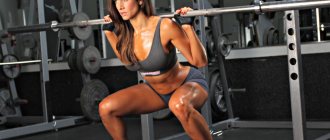Pull-ups are the very first physical exercise that became available to humans. When our ancestors were monkeys, they spent a huge amount of time in the trees, demonstrating miracles of acrobatics and flexibility on the branches. In addition, this is a good basic exercise that allows you to master your body. If you have not yet become familiar with this type of training, then it’s time to add a pull-up circuit to your training program. And literally in 3-4 months you will be able to demonstrate good strength indicators. But before moving on to practice, you need to devote at least a little time to useful information and become familiar with the general principles of training and the technical subtleties of the exercise. Theoretical knowledge will allow you to progress faster in your results and avoid common mistakes.
Basic principles of training using pull-ups on a horizontal bar
Regularity, breathing and technique are the golden rules for effective, and most importantly, safe pull-ups. It is very important to follow these fundamental principles:
- Regularity. Sport does not like the lazy, so if you are determined to master at least a simple pull-up pattern on a horizontal bar for beginners, then be prepared to go all the way. Muscles have a fantastic memory, but they also quickly become detrained, so it is extremely important to exercise regularly. Don’t look for excuses to skip a workout; in critical cases, you can do a lighter version of the workout using a shortened program, the main thing is that the muscles receive at least a little load.
- Breath. This is a fairly heavy strength exercise, so it is important to monitor the air circulation in the body. Under no circumstances should you hold your breath while exerting force; this increases blood pressure and can provoke rupture of blood vessels or an attack of asphyxia. In the positive phase of the exercise (when rising), you need to inhale, and in the negative phase (when lowering), you need to exhale.
- Technique. If you've been doing pull-ups for a long time, but your progress has stopped and the number of repetitions is not increasing, most likely the issue is in technique, and not in your physiological limits. If you pull yourself up with your arms, sooner or later you will reach the apogee of your capabilities, because these are rather small muscle groups and they are not adapted to heavy loads. In order for your workouts to become more effective and efficient every week, you need to learn how to involve your back muscles in the work; for this it is important to master the correct technique and bring it to automaticity.
Is it possible to do pull-ups every day?
Muscles in the human body are divided into three categories - large, medium and small. Each group needs different time for complete recovery, that is, rest and readiness for a new load. The large back muscles that are involved in pull-ups need 4-5 days to recover, the medium ones (deltoids) 3-4 days, and the small ones, such as the arm muscles, will need 1-2 days.
Consequently, the large muscles involved in pull-ups are unable to rest in one day and fully perform the exercise with renewed strength.
If you do pull-ups every day, such training will only lead to muscle fatigue, neither growth nor increase in strength. Tired muscles are unable to perform full loads, despite the athlete’s goals. This means that you won’t be able to increase the number of pull-ups or build sculpted muscles. If you do pull-ups even 10 times every day, even if the load is not maximum, the muscles will still experience fatigue and will not be able to recover properly, which means that the training will not provide any benefit. In addition, muscles that are tight and inflamed from daily stress will be most susceptible to injury - sprains, tears.
Mastering the technique: classic pull-ups
Before moving on to the scheme for increasing pull-ups on the horizontal bar, you need to master the technique of the classic version of the exercise. One repetition consists of four main phases, time and effort are distributed between them as follows:
- body lifting phase (35%);
- fixing the position at the top point (20%);
- phase of lowering the body (35%);
- pause before next repetition (10%);
One very important nuance should be taken from this: pull-ups are not only lifting your own body, but also lowering it. It is important to put effort into both the positive and negative phases of the exercise. Many beginners neglect this rule and simply relax their arms to return the body to its original position. Of course, this will allow you to do more repetitions, but the effectiveness of the exercise will suffer greatly, because a huge number of muscle groups work precisely during the lowering. Also, do not ignore the pause at the top point of the trajectory. It has been proven that static loads engage muscle fibers more actively than dynamic training.
Now let's take a closer look at the technology:
- Select your preferred grip option and hang from the pull-up bar. The body should be tense.
- Concentrate all your attention on your back, namely on the latissimus muscles, try to feel their stretch.
- By contracting the muscles of your back and arms, lift your body up, preferably so that your chin is above the bar.
- Be sure to pause at the top point.
- Slowly begin to lower your body down.
- Do not allow your arms to completely relax; start the next repetition before the elbow joint has completely straightened.
An effective alternative: head pull-ups
If you choose a pull-up pattern on a horizontal bar for muscle growth, then in addition to the classic version, there will be pull-ups by the head. Biomechanically, these exercises are very similar. In the usual version, not only the back and arms work, part of the load is “stolen” by the pectoral muscles. If you want to fully concentrate on your lats, rhomboids, and trapezius, be sure to use overhead pull-ups. The technique is similar: you just need to place the bar behind your head and try to rise to the very base of your neck. A similar exercise can be performed in a simulator - lat pulldown in a crossover.
Benefits of Pull-Ups
Varieties of grip
Of all types of physical activity, pull-ups on the horizontal bar stand out because they train six types of muscles at once:
- pectoral muscles;
- biceps;
- abdominal muscles;
- latissimus dorsi muscles;
- muscles of the forearms;
- brachialis (shoulder muscle).
Moreover, the grip method affects which muscle group you want to increase.
The further apart the hands are on the bar, the better the group of latissimus dorsi muscles develops. The close placement of the hands puts stress on the biceps and triceps. And the ideal grip for developing all six types of muscles is 10 cm further from shoulder width.
The high efficiency of these exercises allows you to achieve the same results in 30 days as in three months of intense training in the gym. Another plus is the benefits for the spine. Thanks to sagging and stretching, in 10-15 sessions you can eliminate sharp pain due to osteochondrosis and other diseases.
A good way to vary your workout: dips
If you want to diversify your workouts a little, then in addition to the horizontal bar, you can also use parallel bars. Despite the fact that almost the same muscles are involved in the exercises, the load is slightly different. The parallel bars train the chest more strongly, and the horizontal bar targets the back, but the arms are involved everywhere. Various pumping methods allow you to recruit more muscle fibers into work. There are two types of bars: wide and narrow. The principle of distributing the load between the muscles is similar to the choice of grip when doing pull-ups; the wider, the more the back and chest work. In a narrow position, the arms are well worked, especially the triceps. To engage more muscles in the work, you can combine the pull-up pattern on the horizontal bar and the parallel bars program. Moreover, the second apparatus allows you to perform many more different exercises, from classic push-ups to various types of walking.
The influence of grip on the activation of working muscles during pull-ups
Before moving on to the actual pull-up pattern on the horizontal bar, you need to decide on your grip. After all, the purpose of your training will depend on the position of your hands. Types of grip:
- Middle straight - the entire back and biceps work the most, part of the load goes to the middle deltoids.
- Medium reverse – targeted pumping of the latissimus and biceps brachii muscles.
- Wide grip (classic) - in addition to the wings, the trapezius is included in the training.
- Wide grip (behind the head) – concentrated work on the entire back: from the trapezius to the lower back.
- Narrow straight - of the back muscles, the lower lobes of the wings are most involved, but the main part of the load falls on the triceps and serratus muscles.
- The narrow reverse is a good option for pumping up your biceps.
- Neutral (along the bar) – excellent work on all the deltas and serratus muscles of the shoulder.
Preparation for the program and strength test
And now you can move on to the pull-up pattern on the horizontal bar from scratch. But before starting training, it is necessary to conduct a strength test in order to assess the initial level of your training. Based on this figure, you will understand what week you should start classes. After all, the program is designed even for people who cannot do a single pull-up. The starting point is usually the number of pull-ups you can do with a medium overhand grip. The exercise must be performed according to technique, avoiding cheating and swinging; lifting and lowering must be in full amplitude.
Also, before starting classes, it is necessary to carry out some preparatory work, namely, take care of a comfortable room. It is best to exercise in the gym or outside, but if you are training at home, the room should be well ventilated. The height of the horizontal bar should correspond to your height, your feet should not touch the floor.
Scheme for beginners: increasing strength and endurance
What does a pull-up pattern look like in 30 weeks? It's actually simple. Each week you will have three workouts, in one you need to do 5 approaches. The progression of loads is distributed as follows:
- First approach: the initial number of repetitions is 6, every odd week the number of repetitions increases by 1. This means that in the first and second weeks there will be 6 repetitions, and in the third there will be 7, and so on until the end.
- Second approach: the initial number of repetitions is 5, every odd week the number of repetitions increases by 1.
- Third approach: the initial number of repetitions is 5, every third week the number of repetitions increases by 1.
- Fourth approach: the initial number of repetitions is 4, every odd week the number of repetitions increases by 1.
- Fifth approach: initial number of repetitions – 3, every third week the number of repetitions increases by 1.
If you are a complete beginner, then in the first month you will have to master the technique of the exercise itself, and after that you can work to improve the result.
Next up is principle number 3, which says...
Break all your pull-ups up into several sets per day, as doing enough sets in a week to produce the desired training effect is much easier than achieving the same thing by focusing only on the number of repetitions in one set.
So, your task is to do only 10 pull-ups on the first day. Given the previous principle that you need to give 50-80% of your ability in one set, you need to break up the final number of pull-ups into several sets.
For example, if the maximum number of pull-ups you can do in one approach is 5 times, then do, for example, a couple of sets of 2 pull-ups on the horizontal bar in the morning (that’s already 4), and then in the evening do the remaining 6 pull-ups in 2-3 approaches.
It is very important to feel that you have strength at the end of the day. ATTENTION – if there is no such feeling, then it is better to break the pull-ups into EVEN MORE approaches!
Choose the most optimal number of approaches during the day and follow the points that we have already talked about:
- do the planned number of pull-ups (10, 11, 12, etc.)
- add one pull-up every day (women can do two)
- do each approach at 50-80% of your strength capabilities
Second week: negative phase of the exercise
We continue to master the pull-up pattern on the horizontal bar. In week number two you will study the negative phase of the exercise - lowering down. To do this, you will need a chair or the help of a partner. This imitation of pull-ups will help you learn to concentrate on the working muscles and gradually increase your strength. The exercise should start from the top point of the trajectory; to do this, climb onto the bar with the help of a chair or an assistant, and then slowly lower down, doing this precisely with the efforts of the back muscles.
Progression
After eight weeks of training, your strength will increase significantly. In addition to this, your shoulders will become stronger and stronger, your back will become more powerful and wider. The strength of the entire body as a whole will increase.
For people who have more body weight, pull-ups are harder, regardless of muscle size. If you are in the muscular category, simply use pull-ups to develop more strength. On the other hand, if you have significant body fat, then you need to lose those extra pounds to make your pull-up training easier and increase your results.
Third week: consolidation of results
Next, the pull-up scheme on the horizontal bar for 30 weeks is designed to consolidate the result. The following three workouts must be alternated between two exercises:
- lowering phase;
- pull-ups with the help of a partner, and if you work out in the gym, you can do this in a gravitron.
You need to perform 3-4 sets of each exercise, approximately 10 or 15 repetitions. Be guided based on your physical capabilities. It is important to strengthen the muscles as much as possible before the last preparatory week.
Where to begin?
For muscle growth, pull-ups on the horizontal bar are one of the available exercises. In order to engage in this type of training, no special training is required; you can start almost from scratch. The most common is the pull-up scheme, which involves increasing the total number of exercises to 30 or more times in 30 weeks.
This scheme is popular among beginners, but is quite complex in terms of loads. If you have poor endurance, it is better to resort to a more gentle method of muscle training, since this one is designed for one day off per week. Not every person is able to withstand such loads, but the opportunity to increase muscle volume in 30 weeks motivates many to choose this particular method.
As can be seen from the table, the exercises are designed to increase every day by one pull-up per approach. There are five approaches in total; there should be a 2-3 minute break between them. If you feel that you can do more, then increase the amount, but without much sacrifice. And vice versa, if you don’t have the strength, then it’s better not to overwork (to avoid injuries) and it’s even acceptable to rest for one or two days.
You should pause your classes if you are sick or injured. It is better to miss 10-15 days than to go to bed for a month or more from the results of your own negligence. After a long break, it is better to start training again. If the break was short, then we start from the place in the diagram where we left off.
In this way, you will be able to do 15 pull-ups in one set after just 15 weeks. And this, admit it, is a serious achievement. Within a month, the result of muscle growth will be obvious. And in 30 weeks, with intensive training, you can achieve 80 pull-ups in five approaches. And this is not the limit, each person is unique and your personal result may be greater. By devoting 15-20 minutes a day to training, you can not only increase the volume of your back and arm muscles, but also become more confident.
Scheme for advanced: weight training program
As soon as you have mastered the previous program, you can safely move on to the pull-up pattern on the horizontal bar for muscle growth. Here, various types of exercises will alternate, which were described in detail in the article.
Exercises with number of approaches and repetitions:
- classic medium grip – 3 to 15;
- classic per head – 3 to 15;
- wide grip to the chest – 4 to 20;
- narrow grip – 4 x 20;
- bars – 4 to 15;
Training should be carried out at least three times a week and be sure to combine the pull-up pattern on the horizontal bar with other strength exercises. After all, muscle growth requires an integrated approach and the mandatory presence of strength exercises in the program.











